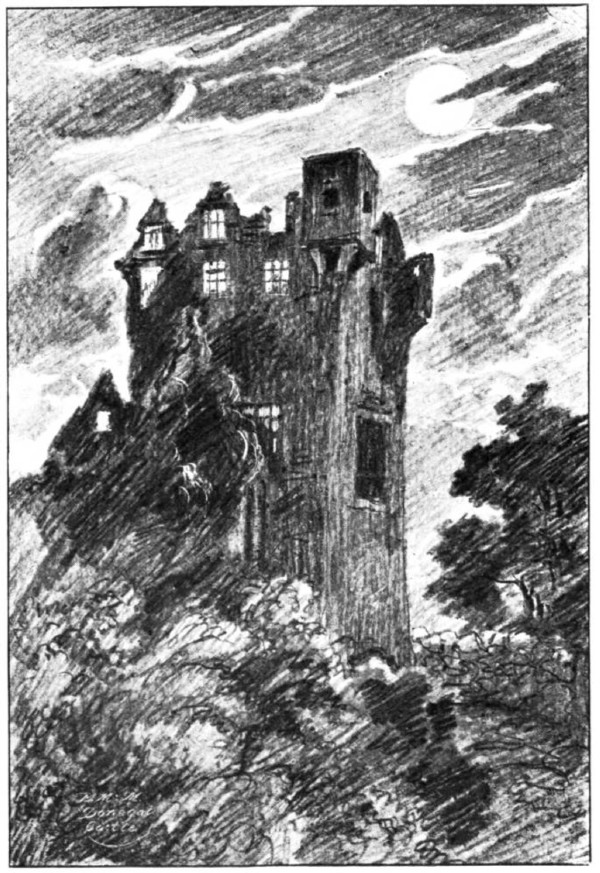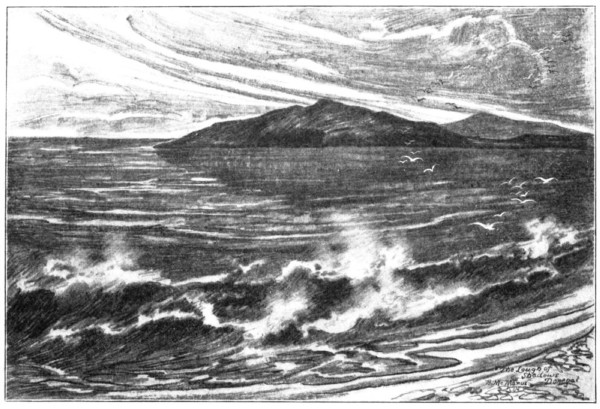| Web
and Book design,
Copyright, Kellscraft Studio 1999-2017 (Return to Web Text-ures) |
 (HOME)
|
|
CHAPTER VIII. THE DONEGAL HIGHLANDS THE Bay of Donegal, and indeed the whole Donegal district, is mellowed and tempered by the everflowing Gulf Stream, which, so the scientists say, were it diverted by any terrestrial disturbance, would give to the entire British Isles the temperature and climate of Labrador. As this event is hardly likely to take place, and certainly cannot be foretold, the interest in the subject must rank with that which one takes in the announcement of the statisticians, for instance, that an express-train travelling at sixty miles an hour would take millions of years to reach Saturn, were it once headed in that direction and had the elevating and sustaining qualities of an air-ship. Certainly, the mean temperature of the whole south and west coast of Ireland is marvellously mild, and that of Donegal is exceptionally so. The cliffs of Slieve League, which form a jagged, many-coloured precipice, rise at a sharp angle from the northern shore of Donegal Bay to the summit of the storm and wave-riven mountain, a rock wall 1,972 feet high. It is a grand and noble headland, as a glance at the map will show, and is one of the most lofty elevations seen from Bundoran and the southern shores of the bay; moreover it is accounted unique in all the world, by reason of its marvellous colouring. Bundoran is a bustling, thriving place, but of the tourist order pur sang, with golf-links, electric lights, and up-to-date hotels, and, for that reason, if for no other, is a place for the genuine lover of the road to avoid. Donegal itself is an improvement. It is a small but attractively placed town at the head of its own bay, and, in spite of its being a coast town, it is more allied with agricultural interests than with trade by sea. The guide-books tell one little of Donegal, and so much the better. One enjoys finding out things for oneself, and so one has practically a virgin field at Donegal unless he will delve deep into frowsy historical works, such as the “Annals” of the “Four Masters” of the old Abbey of Donegal. The retreat where they patched and pieced together this ancient record is no more, but it stood, “proud, grand, and rich” upon the site still marked by some ruinous heaps of stones. Donegal has the usual accompaniment of a castle, but, in this case, it is a sixteenth-century descendant of a former stronghold. It is a fine Jacobean building, built up out of the remnants of its parent, and, with its tall gabled towers and turrets, is in every way a satisfactory example of a medićval baronial residence, though differing in many essentials from those common throughout Ireland. Killybegs, between Donegal and Slieve League, on the north shore of the bay, is one of those picturesque coast villages on a landlocked tiny bay, of which so many examples exist in the British Islands. It is no more attractive, nor any less so, than others, but it has this distinction — a lengthy sojourn there will demonstrate beyond all doubt that one can live far away from a great city and yet never miss its whilom attractions. With many other places similarly situated, a run “up to town” is inevitable and necessary; here, one is apparently as completely isolated from the distractions of the great world outside as if he were marooned on a desert isle, with the advantage, however, of being able to get away at once by means of what, to all appearances, is a toy railway running to Donegal. Carrick is another village a little further on and similarly isolated, — more so, if anything, in that the diminutive engine and its toy carriages stop, in its not rapid course, at Killybegs, and one journeys onward by “car.”
 DONEGAL CASTLE. To the southward are the heights of Slieve League, Malin Beg and Teelin Head, and, if one will brave the waves to the extent of rounding these headlands by boat, he will then experience something of the feeling which inspired the following lines, which, if rather pretentious, are in no way fulsome: “Once seen in morning sunshine, the view of the southern face of Slieve League, rising steeply from the sea, can never be forgotten; the impressiveness and matchless colouring of the rock defy description; its beauty must be seen to be believed. Its glorious colours are grouped in masses on the mountain’s face: stains of metal, green, amber, gold, yellow, white, red, and every variety of shade are observed, particularly when seen under a bright sun, contrasting in a wonderful manner with the dark blue waters beneath.” Some one has compared these variegated cliffs to the effects to be seen, elsewhere, only in the Yellowstone Park and the canyons of Arizona or Colorado. Those who know Bierstadt or Moran’s paintings of these wonders of nature, or, better yet, the originals themselves, will appreciate the comparison. The festival of St. Adamnan, eighth in descent from the great King Nial and from Conal, the ancestor of St. Columbkille, is kept with great solemnity in many churches in Ireland, of which he is titular patron, and in the whole diocese of Raphoe, in the county of Donegal, of which he was a native. The abbatial church of Raphoe was changed into a cathedral soon after, when St. Eunan was consecrated the first bishop. He originally entered the monastery founded by St. Columba, and became its fifth abbot. In 701 he was appointed ambassador to King Alfred of the Northern Saxons, to demand reparation for the injuries committed upon Irish subjects in Neath. It was St. Adamnan who first prevailed upon the Church authorities in Ireland to celebrate Easter at the true and appointed time. When he died, he left among his effects a treatise on the right time of keeping Easter, which disposed his people sometime after to forsake their erroneous computation. He wrote, too, the life of St. Columbkille, and also certain canons, and a curious description of the Holy Land as that country stood in his time. This book furnished the Venerable Bede with his principal memorials. In this work on the Holy Land, St. Adamnan mentions the tombs of St. Simeon and of St. Joseph at Jerusalem, and many relics of the passion of Christ, as well as the impression of the feet of the Saviour on Mount Olivet, covered with a church of a round figure, with a hole open on the top, over the impression of the footsteps. He also mentions grasshoppers in the deserts of the Jordan, which the common people eat, boiled with oil; and a portion of the Cross in the Rotunda Church in Constantinople, which was exposed on a golden altar on the three last days of Holy Week, when the emperor, court, army, clergy, and others went to the church at different hours, to kiss that sacred wood. Two landmarks, known to all travellers to the Clyde from America, by way of the north of Ireland, are The Bloody Foreland and Tory Island. The guide-books tell but little concerning this wild land of promontory and cliff, and with some reason, too, for there is little or no population there, except the fisherfolk and a rather primitive race of agriculturists. Donegal is assuredly a land of intermittent beauty, and the hill-encircled loughs and the verdant glens of Donegal Bay give way here to a stern, relentless gray stone formation, with here and there patches of green and purple which indicate nothing so much as the lonesomeness which is inevitable under such conditions. But there is an impressiveness in it all which is inexplicable, since the scenery, though by no means tame, is not of the grandeur of many other parts. It is doubtful if Tory Island — which is but a mere name, even to the few who know it at all — will ever be inundated by any large flow of travel. If it was, there would doubtless be little accommodation provided for them, for the simple reason that it does not exist, though the island is possessed of a population of some hundreds of men and women and children, with schools and a church — in fact two, which are ever a point of contention and argument among their respective constituencies. It was not long since that the cleric in charge of one of these houses of God nearly starved, because he would not desert his post, and “the powers that be” on the mainland had evidently abandoned him to his fate, or had forgotten him altogether.
 LAKE OF SHADOWS, DONEGAL. Between the Tory Island and Malin Head, that other beacon-light for seafarers, is the great inlet or fiord of Lough Swilly, meaning in Celtic “Lake of Shadows,” which, though quite as beautiful as Lough Foyle, its neighbour on the east, is, for some unexplained reason, quite neglected. Of Lough Foyle, at the head of whose ample waters sits that city familiarly called Derry, — built by certain citizens of London in the reign of James I., — Sir Walter Scott has said: “Nothing can be more favourable than this specimen of Ireland — a beautiful variety of cultivated slopes, intermixed with banks of wood; rocks skirted with a distant ridge of healthy hills, watered by various brooks; the glens or banks being in general planted or covered with copse.” This is not a particularly vivid statement, to be sure, but it is true and temperate, and far more likely to fit in with the views of the casual observer than the rather florid word-paintings of other parts of Ireland which have been offered by rhapsodists of all shades of opinion. |